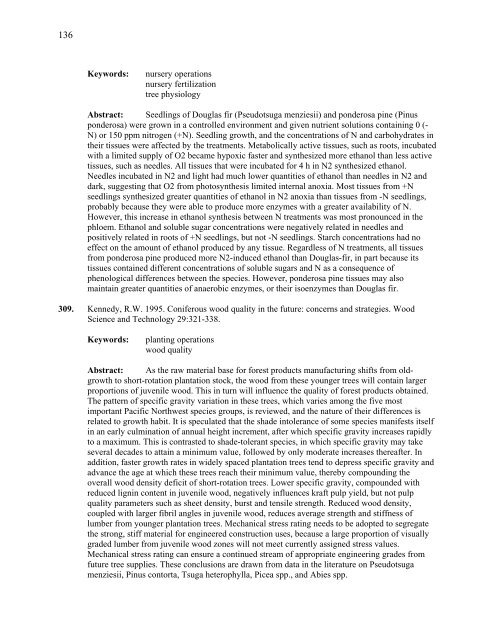IntensIve sIlvIculture - Forest Science Labs - Research Network ...
IntensIve sIlvIculture - Forest Science Labs - Research Network ...
IntensIve sIlvIculture - Forest Science Labs - Research Network ...
Create successful ePaper yourself
Turn your PDF publications into a flip-book with our unique Google optimized e-Paper software.
136<br />
Keywords: nursery operations<br />
nursery fertilization<br />
tree physiology<br />
Abstract: Seedlings of Douglas fir (Pseudotsuga menziesii) and ponderosa pine (Pinus<br />
ponderosa) were grown in a controlled environment and given nutrient solutions containing 0 (-<br />
N) or 150 ppm nitrogen (+N). Seedling growth, and the concentrations of N and carbohydrates in<br />
their tissues were affected by the treatments. Metabolically active tissues, such as roots, incubated<br />
with a limited supply of O2 became hypoxic faster and synthesized more ethanol than less active<br />
tissues, such as needles. All tissues that were incubated for 4 h in N2 synthesized ethanol.<br />
Needles incubated in N2 and light had much lower quantities of ethanol than needles in N2 and<br />
dark, suggesting that O2 from photosynthesis limited internal anoxia. Most tissues from +N<br />
seedlings synthesized greater quantities of ethanol in N2 anoxia than tissues from -N seedlings,<br />
probably because they were able to produce more enzymes with a greater availability of N.<br />
However, this increase in ethanol synthesis between N treatments was most pronounced in the<br />
phloem. Ethanol and soluble sugar concentrations were negatively related in needles and<br />
positively related in roots of +N seedlings, but not -N seedlings. Starch concentrations had no<br />
effect on the amount of ethanol produced by any tissue. Regardless of N treatments, all tissues<br />
from ponderosa pine produced more N2-induced ethanol than Douglas-fir, in part because its<br />
tissues contained different concentrations of soluble sugars and N as a consequence of<br />
phenological differences between the species. However, ponderosa pine tissues may also<br />
maintain greater quantities of anaerobic enzymes, or their isoenzymes than Douglas fir.<br />
309. Kennedy, R.W. 1995. Coniferous wood quality in the future: concerns and strategies. Wood<br />
<strong>Science</strong> and Technology 29:321-338.<br />
Keywords: planting operations<br />
wood quality<br />
Abstract: As the raw material base for forest products manufacturing shifts from oldgrowth<br />
to short-rotation plantation stock, the wood from these younger trees will contain larger<br />
proportions of juvenile wood. This in turn will influence the quality of forest products obtained.<br />
The pattern of specific gravity variation in these trees, which varies among the five most<br />
important Pacific Northwest species groups, is reviewed, and the nature of their differences is<br />
related to growth habit. It is speculated that the shade intolerance of some species manifests itself<br />
in an early culmination of annual height increment, after which specific gravity increases rapidly<br />
to a maximum. This is contrasted to shade-tolerant species, in which specific gravity may take<br />
several decades to attain a minimum value, followed by only moderate increases thereafter. In<br />
addition, faster growth rates in widely spaced plantation trees tend to depress specific gravity and<br />
advance the age at which these trees reach their minimum value, thereby compounding the<br />
overall wood density deficit of short-rotation trees. Lower specific gravity, compounded with<br />
reduced lignin content in juvenile wood, negatively influences kraft pulp yield, but not pulp<br />
quality parameters such as sheet density, burst and tensile strength. Reduced wood density,<br />
coupled with larger fibril angles in juvenile wood, reduces average strength and stiffness of<br />
lumber from younger plantation trees. Mechanical stress rating needs to be adopted to segregate<br />
the strong, stiff material for engineered construction uses, because a large proportion of visually<br />
graded lumber from juvenile wood zones will not meet currently assigned stress values.<br />
Mechanical stress rating can ensure a continued stream of appropriate engineering grades from<br />
future tree supplies. These conclusions are drawn from data in the literature on Pseudotsuga<br />
menziesii, Pinus contorta, Tsuga heterophylla, Picea spp., and Abies spp.
















